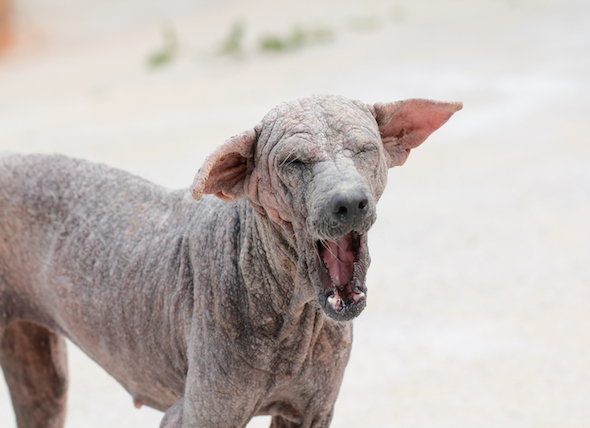

Sarcoptic mange is a highly contagious skin disease found in dogs, caused by the Sarcoptes scabiei mite. These mites will burrow through the skin causing intense itching and irritation. The scratching that results from mange is what causes the majority of the animal's hair to fall out. This is a treatable medical condition, but is highly contagious for other animals and humans. Pet owners are advised to keep the dog quarantined while it is being treated for mange.
The most common cause of mange in dogs is exposure to another infected animal, as the mites quickly move from animal to animal. Kennels, animal shelters, dog parks, groomers and veterinary clinics have a high exposure rate of mange due to the close proximity with animals that are infected. The exposure generally occurs about two to six weeks before the first symptoms of mange are displayed.
After ruling out food allergies, chiggers, and bacterial infections of the skin (folliculitis), your veterinarian will conduct a physicial inspection of your dog to identify the type of microorganism that may have embedded into its skin; in this case, mites.
Dogs that have a non-seasonal form of sarcoptic mange will likely be treated with a scabicide -- a drug that kills the itch mite. In some cases, the animal will be dipped in a scabicidal shampoo to kill all of the mites living in its skin. Ongoing treatment is necessary to kill all of the mites as the eggs will take time to hatch, and most treatments do not kill the eggs, only the living mites. Treatment of this condition should be done under veterinary supervision and the dog’s entire body must be treated with the scabicide treatment and/or scabicidal shampoo to be sure the mites are eliminated entirely. Many different treatments can be used to treat the issue (and some may not work because the mites have developed resistance to certain treatments) and can include such scabicidal dips as invermectin, selamectin, lime-sulfur and doramectin. Depending on your dog’s condition, it may need to be dipped on a weekly basis for as long as six consecutive weeks. Oral medications can also be a part of the treatment.
Complete response to the therapy may take between four to six weeks. Also, because of how contagious this type of mange is to humans and other animals, it is recommended you limit contact with the dog. In extreme cases, quarantining the animal may be required.
Humans who do come into contact with a dog infected with mange may develop a purplish rash on their arms, chest or abdomen. The issue will typically clear up once the dog with has been properly treated. A healthy immune system can help prevent the recurrence of the problem, so it’s important to keep your dog as comfortable as possible throughout the treatment. This can include keeping your dog on a regular feeding schedule and giving it a comfortable place to sleep that is independent of furniture or bedding humans in the home may use but still allows them to feel like part of the family.
There are currently no known preventative measures for sarcoptic mange.
Mange in Dogs
Sarcoptic vs. Demodectic Mange in Dogs
Skin Disease in Dogs
Demodetic Mange in Dogs
 Skin Disease (Dermatophilosis) in Dogs
Dermatophilosis in Dogs
Dermatophilosis is a skin
Skin Disease (Dermatophilosis) in Dogs
Dermatophilosis in Dogs
Dermatophilosis is a skin
 Skin Cancer (Squamous Cell Carcinoma) in Dogs
Cutaneous Squamous Cell Carcinoma in Dogs
The epi
Skin Cancer (Squamous Cell Carcinoma) in Dogs
Cutaneous Squamous Cell Carcinoma in Dogs
The epi
 Excess Protein in the Urine of Dogs
Proteinuria in Dogs
Abnormally high protein level
Excess Protein in the Urine of Dogs
Proteinuria in Dogs
Abnormally high protein level
 Bacterial Infection (Tularemia) in Dogs
Francisella tularensis in Dogs
Tularemia is a zoo
Bacterial Infection (Tularemia) in Dogs
Francisella tularensis in Dogs
Tularemia is a zoo
 Fever in Dogs
Pyrexia in Dogs
Fever, referred to medically as p
Fever in Dogs
Pyrexia in Dogs
Fever, referred to medically as p
Copyright © 2005-2016 Pet Information All Rights Reserved
Contact us: www162date@outlook.com